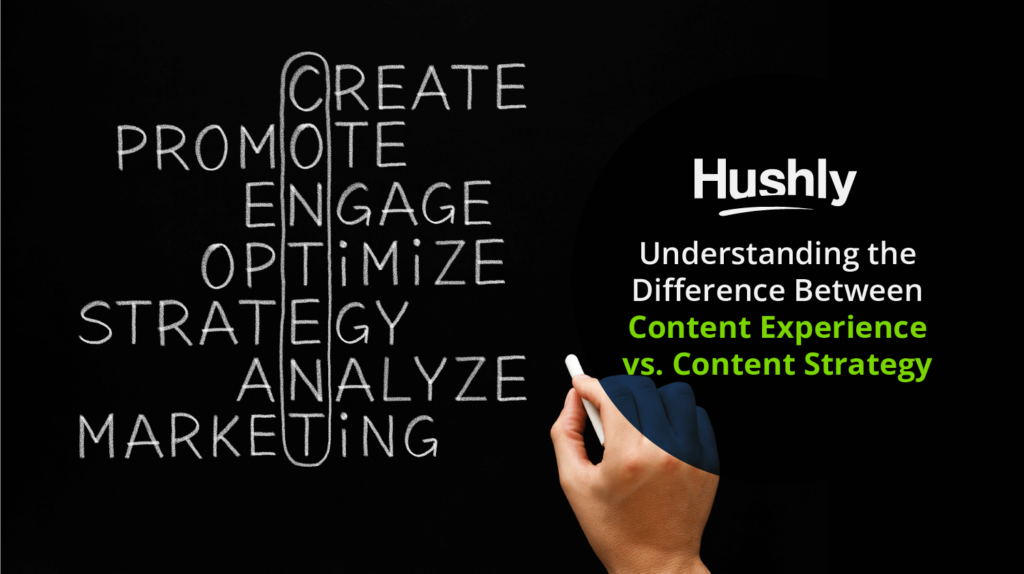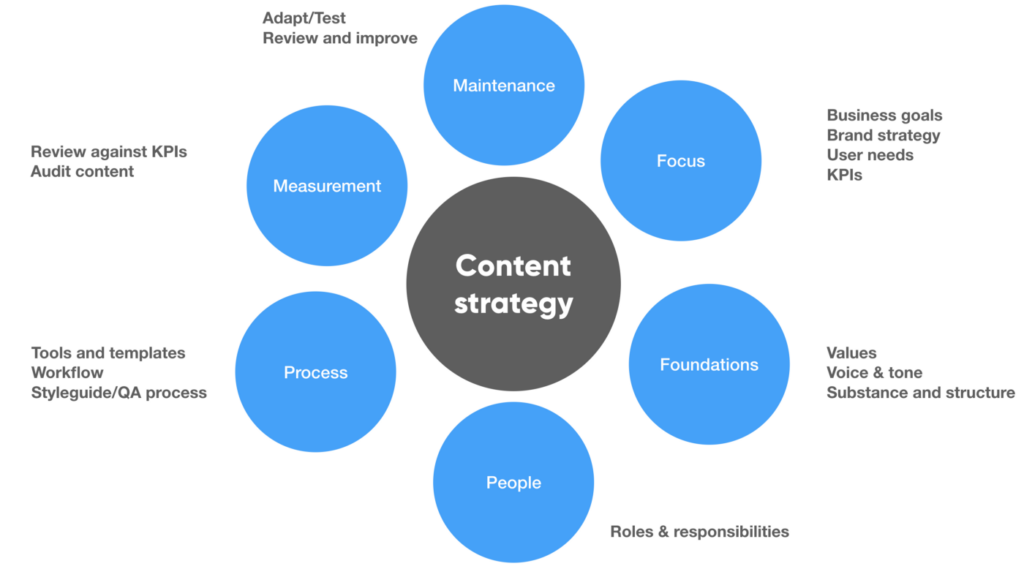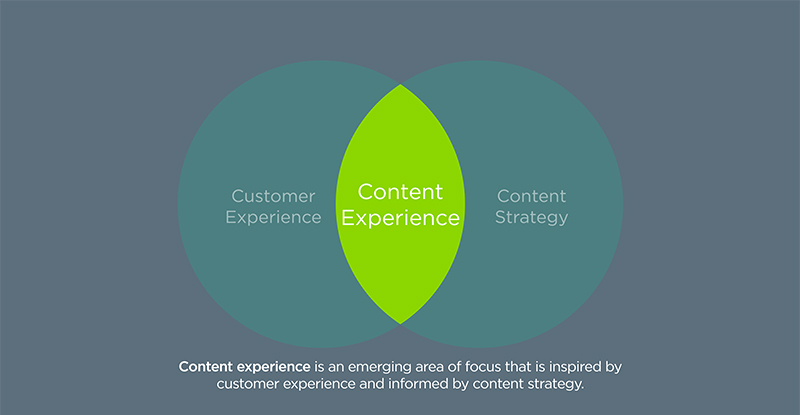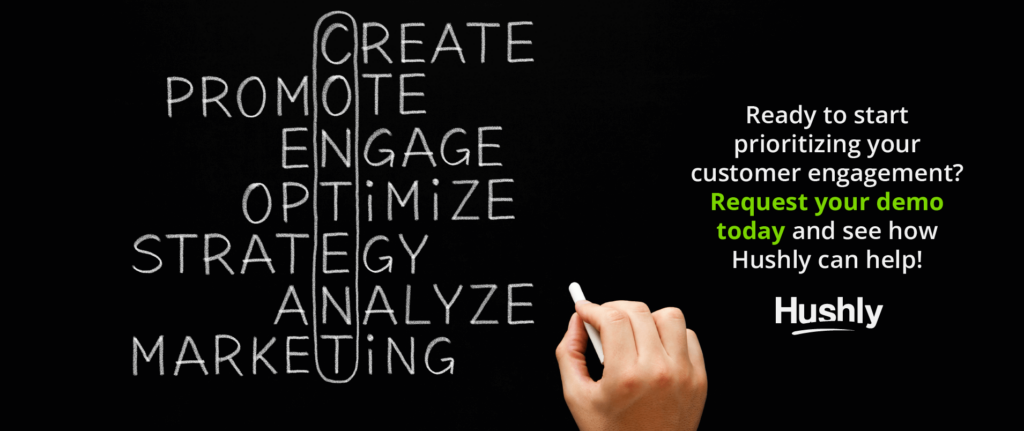Content experience and content strategy are two crucial elements of a strong marketing strategy. Both disciplines can help shape how your brand is represented online. Unfortunately, when it comes to content experience vs. content strategy, many marketers often find themselves using these two terms interchangeably, not realizing that they are two different disciplines. It is essential to understand the difference between the two and how each can help shape your brand.

Content Experience vs. Content Strategy
In the B2B world, content must work harder to connect with your audience. You have to provide more content, and you have to create something valuable for them. However, you can’t just throw some content at your audience and then call it a day. The way people consume content has changed, and you need to change along with it – which is why understanding the difference between content experience vs. content strategy is so crucial.
Content Strategy
Content strategy is the blueprint for how your content will be created, distributed, and optimized for consumption by your ideal target audience.

Source: Medium
The goal of your content strategy is to drive engagement and build a long-lasting relationship with your audience. This means that your content needs to be relevant, helpful, and consistent. It also means that you need to carefully plan out how your content will be distributed across digital channels and what types of content your audience will respond to the most.
That means you need to consider more than just what you’re writing and where you’re sharing it, but also what effect that content has on your audience.
Content Experience
Content experience can be defined as the experience of accessing, consuming, and engaging with content across all mediums throughout your audience’s journey with your brand.
One of the easiest ways to picture the content experience is to imagine it as the middle ground between your content strategy and your customer’s experience with your brand. Instead of focusing on the total customer experience, the content experience focuses solely on the experience they receive when accessing and interacting with your content.

Source: Tendo Communications
The content experience is the final layer in your content strategy, and it is crucial to the success of your brand. It’s what ties everything together and creates that one-of-a-kind experience your brand is known for.
Factoring Content Experience into your Content Strategy: 5 Tips
When it comes to creating and delivering quality content to your audience, many moving parts need to come together. One of the most critical yet often overlooked is the balance between content experience and content strategy.
If you’re not quite sure how these two pieces fit together, then you’ll want to check out these five tips:
1. Eliminate the Silos
One of the most prominent mistakes marketers make is focusing on just one aspect of their content strategy. This creates a silo effect and prevents you from delivering a truly holistic customer experience. The first step in overcoming this mistake is to eliminate the silos.
Deciding what content to create, when to create it, and where to create it are all part of your content strategy, but so is your audience’s experience when they consume that content. Instead of focusing your content strategy on just one silo, it’s essential to consider how your creation and distribution strategy supports the overall customer experience for all necessary departments. This will help you identify the areas that are lacking and provide you with the opportunity to adjust accordingly.
By eliminating silos, you bring together content teams from across departments and create a more cohesive content experience for your audience.
2. Develop a Customer-Centric Mindset
You can’t succeed in today’s competitive landscape without a customer-centric mindset. The more you understand your customers, the better decisions you will make to deliver quality content.
This means understanding what content your audience is looking for and how they expect to receive that content. Suppose your audience consumes your content through social media, but you have your marketing team distributing that content through email campaigns. In that case, this will create a sub-optimal experience for your audience.
To deliver a customer-centric experience, you need to factor in the channels your audience is using to receive your content and create a strategy that supports those channels.
3. Audit Your Current Content
Once you’ve brought your content teams together and have started assessing your audience’s wants and needs, it’s time to take a closer look at the content that currently exists in your system. This will allow you to see what’s been working and what hasn’t.
By auditing the content that currently exists in your system, you can start to understand better which pieces are connecting with your audience and which are not. This will help you to identify the gaps in your strategy and provide you with the opportunity to adjust accordingly.
4. Map Out New Content Ideas
One of the most critical aspects of creating a successful content experience is the creation of new content ideas. Without a steady stream of new ideas, you will be unable to provide your audience with the content they need.
However, new content doesn’t always need to be created from scratch. Sometimes, it’s as simple as adapting existing content to fit the needs of your audience better. By mapping out all of the content ideas you want to explore, you can better assess which pieces are worth creating from scratch and which can be adapted from your current content.
When creating a new piece of content, it’s essential to understand its purpose and who it is intended to serve. This will help you better identify the topics your audience is interested in and help you create content that provides them with an experience worth their time.
5. Monitor and Adjust Your Content as Necessary
Finally, when it comes to determining both the success of your content experience and content strategy, you must take the time to carefully monitor both the overall success of your content and the reaction that it’s receiving from your audience. This will allow you to identify the areas that are performing well and provide you with the opportunity to adjust your strategy as necessary.
Make the Most of Your Customer Engagement with Hushly
When it comes to creating a successful content experience, one of the most important things you can do is make the most of your customer engagement.
By using a platform like Hushly, you can create engaging content that your audience will want to read. Hushly provides you with the ability to personalize your content and track the performance of each piece of content that you create. This allows you to identify the most engaging content and provide your audience with the content they are looking for without compromising the quality of the experience.
Ready to start prioritizing your customer engagement? Request your demo today and see how Hushly can help!

